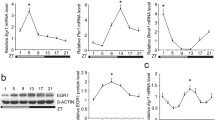Abstract
The mammalian period (Per) genes which are components of the circadian clock are mainly regulated via an autoregulatory feedback loop. Here we show that a human PER1 (hPER1) reporter gene activity is stimulated by interleukin-6 (IL-6), a member of the large cytokine gene family and an inducer of the acute phase reaction, in human hepatoma (HuH-7) cells. Our results confirm and extend the view that the hPER1 promoter acts as a sensor for multiple signaling molecules thereby integrating different physiological parameters.
Similar content being viewed by others
References
Akashi M. and Nishida E. (2000) Involvement of the MAP kinase cascade in resetting of the mammalian circadian clock. Genes Dev. 14, 645–649.
Akira S., Isshiki H., Sugita T., et al. (1990) A nuclear factor for IL-6 expression (NF-IL6) is a member of a C/EBP family. EMBO J. 9, 1897–1906.
Albrecht U., Sun Z. S., Eichele G., and Lee C. C. (1997) A differential response of two putative mammalian circadian regulators, mper1 and mper2, to light. Cell 91, 1055–1064.
Aschoff J. (1981) A survey on biological rhythms. In: Biological Rhythms, Vol. 4, Handbook of Behavioral Neurobiology, Vol. 4 (Aschoff J., ed.), Plenum, New York.
Balsalobre A., Damiola F., and Schibler U. (1998) A serum shock induces circadian gene expression in mammalian tissue culture cells. Cell 93, 929–937.
Balsalobre A., Marcacci L., and Schibler U. (2000) Multiple signaling pathways elicit circadian gene expression in cultured Rat-1 fibroblasts. Curr. Biol. 10, 1291–1294.
Dunlap J. C. (1999) Molecular bases for circadian clocks. Cell 96, 271–290.
Field M. D., Maywood E. S., O’Brien J. A., Weaver D. R., Reppert S. M., and Hastings M. H. (2000) Analysis of clock proteins in mouse SCN demonstrates phylogenetic divergence of the circadian clockwork and resetting mechanisms. Neuron 25, 437–447.
Gillette M. U. (1996) Regulation of entrainment pathways by the suprachiasmatic circadian clock: sensitivities to second messengers. Prog. Brain Res. 111, 121–132.
Hida A., Koike N., Hirose M., Hattori M., Sakaki Y., and Tei H. (2000) The human and mouse Period1 genes: five well-conserved E-boxes additively contribute to the enhancement of mPer1 transcription. Genomics 65, 224–233.
Morgan P. J., Ross A. W., Graham E. S., Adam C., Messager S., and Barrett P. (1998) oPer1 is an early response gene under photoperiodic regulation in the ovine pars tuberalis. J. Neuroendocrinol. 10, 319–323.
Motzkus D., Maronde E., Grunenberg U., Lee C. C., Forssmann W.-G., and Albrecht U. (2000) The human PER1 gene is transcriptionally regulated by multiple signaling pathways. FEBS Lett. 486, 315–319.
Obrietan K., Impey S., Smith D., Athos J., and Storm D. R. (1999) Circadian regulation of cAMP response element-mediated gene expression in the suprachiasmatic nuclei. J. Biol. Chem. 274, 17,748–17,756.
Schumann G., Huell M., Machein U., Hocke G., and Fiebich B. L. (1999) Interleukin-6 activates signal transducer and activator of transcription and mitogen-activated protein kinase signal transduction pathways and induces de novo protein synthesis in human neuronal cells. J. Neurochem. 73, 2009–2017.
Shearman L. P., Zylka M. J., Weaver D. R., Kolakowski L. F., and Reppert S. M. (1997) Two period homologs: circadian expression and photic regulation in the suprachiasmatic nuclei. Neuron 19, 1261–1269.
Shigeyoshi Y., Taguchi K, Yamamoto S., et al. (1997) Light-induced resetting of a mammalian circadian clock is associated with rapid induction of the mPer1 transcript. Cell 91, 1043–1053.
Sothern R. B., Roitman-Johnson B., Kanabrocki E. L., et al. (1995) Circadian characteristics of interleukin-6 in blood and urine of clinically healthy men. In Vivo 9, 331–339.
Sun Z. S., Albrecht U., Zhuchenko O., Bailey J., Eichele G., and Lee C. C. (1997) RIGUI, a putative mammalian ortholog of the Drosophila period gene. Cell 90, 1003–1011.
Takumi T., Matsubara C., Shigeyoshi Y., et al. (1998) A new mammalian period gene predominantly expressed in the suprachiasmatic nucleus. Genes to Cells 3, 167–176.
Taruscio D., Zoraqi G. K., Falchi M., et al. (2000) The human per1 gene: genomic organization and promoter analysis of the first human orthologue of the Drosophila period gene. Gene 253, 161–170.
Tei H., Okamura H., Shigeyoshi Y., et al. (1997) Circadian oscillation of a mammalian homologue of the Drosophila period gene. Nature 389, 512–516.
Toh K. L., Jones C. R., He Y., et al. (2001) An hPer2 phosphorylation site mutation in familial advanced sleep phase syndrome. Science 291, 1040–1043.
Vgontzas A. N., Papanicolaou D. A., Bixler E. O., et al. (1999) Circadian interleukin-6 secretion and quantity and depth of sleep. J. Clin. Endocrinol. Metab. 84, 2603–2607.
Wingender E., Chen X., Hehl R., et al. (2000) TRANSFAC: an integrated system for gene expression regulation. Nucleic Acids Res. 28, 316–319.
Yagita K. and Okamura H. (2000) Forskolin induces circadian gene expression of rPer1,rPer2 and dbp in mammalian rat-1 fibroblasts. FEBS Lett. 465, 79–82.
Yamaguchi S., Mitsui S., Miyake S., et al. (2000) The 5′ upstream region of mPer1 gene contains two promoters and is responsible for circadian oscillation. Curr. Biol. 10, 873–876.
Zylka M. J., Shearman L. P., Weaver D. P., and Reppert S. M. (1998) Three period homologs in mammals: differential light responses in the suprachiasmatic circadian clock and oscillating transcripts outside of brain. Neuron 20, 1103–1110.
Author information
Authors and Affiliations
Corresponding author
Rights and permissions
About this article
Cite this article
Motzkus, D., Albrecht, U. & Maronde, E. The human PER1 gene is inducible by interleukin-6. J Mol Neurosci 18, 105–109 (2002). https://doi.org/10.1385/JMN:18:1-2:105
Received:
Accepted:
Issue Date:
DOI: https://doi.org/10.1385/JMN:18:1-2:105




